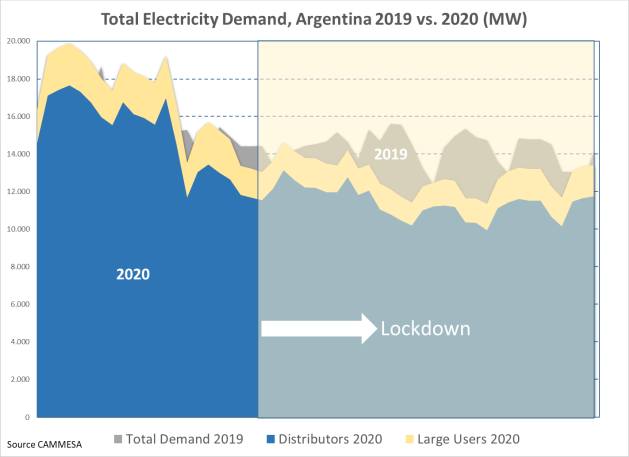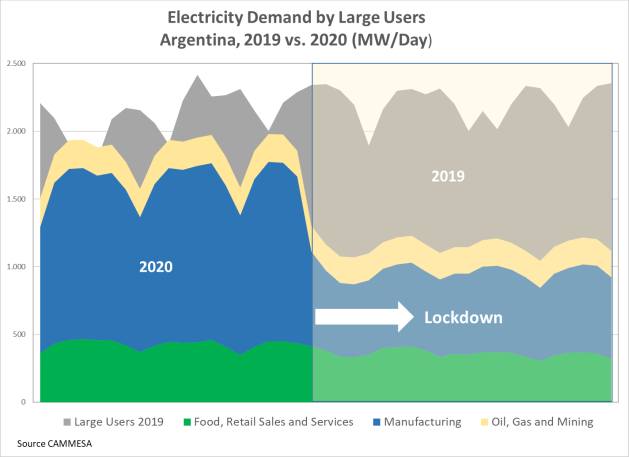Electricity Demand During Lockdown: Evidence From Argentina – Analysis
By IPS
By Andrés Chambouleyron*
Electricity demand normally depends on such variables as retail electricity rates, daytime temperature, time and day of the week, economic activity and consumer type (i.e. residential, commercial, industrial, etc.).
During the period of the COVID-19 pandemic however, there have been dramatic quarantine policies enacted aimed at controlling the virus but with dire economic impacts. The extent of those economic impacts on energy have been widely reported in terms of fossil fuel consumption but what about the electric sector? Has there been a similar reduction in demand and consumption? Moreover, will it be permanent or more temporary?
A residential user will normally consume electricity between 6 pm when they come home after work and 8 am when they leave again peaking at 8 – 10 pm during dinner time. Commercial or industrial electricity demand by contrast will follow the economic activity of each sector during the hours of a typical business day.
The daily aggregate demand curve of both types of users will normally show a two-hump shape with peaks during noon and the evening hours when users go back home after their workday. Also, weekly demand curves will show peaks during weekdays and valleys during weekends reflecting high (low) business activity.
By adding up average daily consumption during a month one should see a curve with ups and downs reflecting high activity during weekdays and low activity during weekends as reflected in the graph below.
This shows total (daily) electricity consumption in Argentina between March 1 and April 22 in 2019 (grey backdrop behind) in contrast with total consumption during the same period in 2020 and broken down by distributors (blue curve) and large users (yellow curve) before and after the mandatory lockdown imposed by Argentina’s government on March 20, 2020.
The lockdown included all economic sectors with very few exceptions: manufacturing and sales of food and basic consumer goods and services.

From the simple observation of the graph above one can see that electricity consumption for both distributors and large users fell after the lockdown imposed on March 20, 2020. More precisely, by taking the difference between the average daily demand of the 10 working days after and those before lockdown, consumption by distribution companies fell by 18.2% and for large users by 32.4% (-20% totally). This reduction is starker after breaking down consumption by large users into 3 groups: food, retail sales and services, manufacturing and oil, gas and mining as shown in the following graph:

The difference between the average daily consumption of the 10 working days after and 10 before lockdown shows manufacturing demand falling by 50.6%, Food, Retail Sales and Services by 15.3% and Oil, Gas & Mining by 3.8%.
By taking the difference in consumption of the same number of (only) working days before and after lockdown we control for several variables. On the one hand retail rates, and on the other economic activity for we know that the latter takes on different values between working days and weekends.
Also, by using a relatively reduced number of working days (10 before and after) we control for another important variable that affects electricity demand: temperature. One can safely assume that temperature did not substantially change in the 20 days that we take as sample to assess the impact of lockdown on electricity demand. Indeed, the average temperature in the Buenos Aires Metropolitan Area fell from 21.6°C during the 10 days before lockdown to only 21.5°C after lockdown (-0.1°C).
Having now controlled for temperature, retail rates, economic activity and working days can we safely conclude that the mandatory lockdown caused a reduction in electricity consumption of the magnitudes already shown? Not yet.
The analysis is still incomplete because we need to know the trend that electricity consumption had before the 20 days under study. In other words, if electricity consumption was already falling at a rate of 10% before our 20 – day sample and continued falling at 10% after lockdown, can we conclude that lockdown caused that fall?
The answer is obviously not, absent the lockdown consumption still would have fallen by 10% and therefore lockdown would have had no impact on it whatsoever. To take that effect into consideration we need a control sample. Ideally, the control sample should show the exact same underlying variables that our test sample but – for the lockdown.
There are two possible ways of doing this, one is to project counterfactual consumption values beyond March 20, 2020 assuming no lockdown but with the same underlying variables (temperature, retail rates, economic activity, working days, etc.) as in reality. The other (much simpler) is to use the difference in consumption of the 10 working days after and before March 20,2019 and compare it with the actual reduction in 2020.
For the sake of simplicity, herewith the latter approach whose results that are shown as follows:

The table shows the actual 2020 reduction in electricity consumption but adjusted for what happened the same 20 days in 2019. For instance, after lockdown we observe a reduction in consumption by Distribution companies of 18,2% however this consumption was already falling by 1,7% during the same days the year before so the net impact of lockdown is the difference, –18,2% – (– 1,7%) = – 16,5% and the same for the rest of the sectors.
This approach should work well as long as there are no substantial differences in temperature and retail rates during both periods, which is the case.
In sum, after controlling for several relevant variables, the impact of mandatory lockdown in the consumption of electricity in Argentina was substantial, ranging from -48,4% in manufacturing to -32,5% in large-scale users to only -8% in Oil, Gas and Mining.
How much of that reduction will be permanent and how much of a more temporary nature? It’s hard to say however most of activities that do not involve the gathering or crowds will go back to normal as soon as the lockdown is lifted, the others (i.e. movies, concerts, restaurants and bars) may see a permanent reduction due to the change in social habits and norms.
*Andrés Chambouleyron is non-resident fellow at the Institute of the Americas

